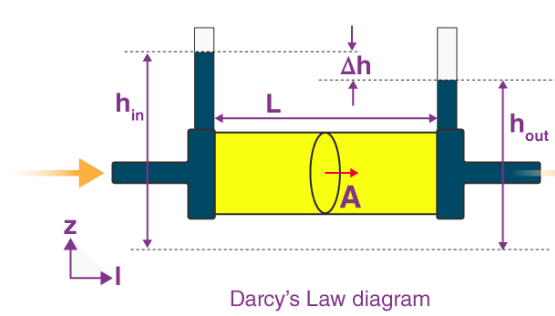Darcy’s Law is a fundamental principle in hydrogeology that describes the flow of fluids through porous media. It was first formulated by Henry Darcy in 1856 and has since become a cornerstone of groundwater flow theory.
Darcy’s Law is used in a variety of applications, including the design and management of groundwater systems, the exploration and production of hydrocarbons, and the study of geological formations.
Darcy’s Law
Darcy’s Law is a fundamental equation used in fluid mechanics that describes the flow of fluids through porous media, such as soil or rock.
Darcy’s Law Equation
It states that the rate of flow of a fluid through a porous medium is directly proportional to the pressure gradient of the fluid and the permeability of the medium.
The law is named after Henry Darcy, a French engineer who conducted experiments on the flow of water through sand filters in the mid-19th century.
The mathematical form of Darcy’s Law is –
Q = -kA(dh/dL)
where Q is the volumetric flow rate, k is the hydraulic conductivity (or permeability) of the porous medium, A is the cross-sectional area of the medium through which the fluid is flowing, and (dh/dL) is the hydraulic gradient or pressure gradient.
Darcy’s Law Application
Darcy’s Law is a fundamental equation in groundwater flow that describes the flow of water through a porous medium.
Darcy’s Law is widely used in hydrogeology and groundwater modeling to predict the flow of groundwater in subsurface environments.
Groundwater exploration: Darcy’s Law is used to estimate the rate of water flows through different geological formations, which helps to identify potential groundwater resources.
Civil engineering: Darcy’s Law is used in the design of drainage systems, dams, and other water management structures.
Geothermal energy: Darcy’s Law is used to estimate the rate of water flows through underground rock formations, which is important for the development of geothermal energy systems.
Properties of Darcy’s Law
Darcy’s Law is a fundamental law of fluid mechanics which has some key properties are –
Linearity: Darcy’s Law is a linear relationship between the flow rate and the pressure gradient.
Directionality: Darcy’s Law assumes that the flow of fluid through a porous medium is in a single direction, which is normal to the plane of the medium.
Steady-state flow: Darcy’s Law assumes that the flow is in steady-state, meaning that the flow rate is constant over time.
Isotropy: Darcy’s Law assumes that the porous medium is isotropic, meaning that its properties are the same in all directions.
Incompressibility: Darcy’s Law assumes that the fluid is incompressible, meaning that its density does not change as it flows through the medium.
Limitation of Darcy’s Law
Darcy’s Law is a useful tool for understanding and predicting fluid flow through porous media, it has certain limitations:
Validity: Darcy’s Law is only valid for laminar flow conditions, i.e., when the flow is slow enough that the fluid moves in parallel layers with no mixing between them.
Homogeneity: Darcy’s Law assumes that the porous medium through which the fluid flows is homogeneous
Single-Phase Fluids: Darcy’s Law is only applicable to single-phase fluids.
Steady-state conditions: Darcy’s Law assumes that the fluid flow is steady-state, i.e., the flow rate and pressure drop do not change with time.
Recommended Articles:
Current Coil: Introduction, Applications, Specifications, And Difference
Current Density: Introduction, Types, And FAQ
Cyclic Process: Introduction, Types, And FAQ
D’alembert’s Principle: Introduction, Derivation, Examples, And Applications
Darcy Weisbach Equation Derivation
Darcy's law is an equation that describes the flow of fluids through porous media. The formula for Darcy's law is Q = -kA(dh/dL) where Q is the volumetric flow rate, k is the hydraulic conductivity (or permeability) of the porous medium, A is the cross-sectional area of the medium through which the fluid is flowing and (dh/dL) is the hydraulic gradient or pressure gradient. Hydraulic conductivity is a measure of the ability of a porous medium to transmit fluids. It is the coefficient of proportionality between the hydraulic gradient and the flow rate in Darcy's law. Darcy's law is a fundamental principle in hydrology and is used to model the flow of groundwater through soil and rock formations. It is also used in engineering applications to design drainage systems and to estimate the rate of contaminant transport in groundwater. The hydraulic gradient is the pressure difference between two points in a fluid divided by the distance between the points. It represents the driving force behind fluid flow through a porous medium. DARCY’S LAW FAQs
What is Darcy's law?
What is the formula for Darcy's law?
What is hydraulic conductivity?
What is the significance of Darcy's law in hydrology?
What is the hydraulic gradient?
